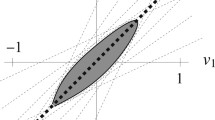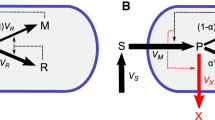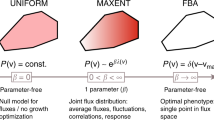Abstract
In this work, the stoichiometric metabolic network ofEscherichia coli has been formulated as a comprehensive mathematical programming model, with a view to identifying the optimal redirection of metabolic fluxes so that the yield of particular metabolites is maximized. Computation and analysis has shown that the over-production of a given metabolite at various cell growth rates is only possible for a finite ordered set of metabolic structures which, in addition, are metabolite-specific. Each regime has distinct topological features, although the actual flux values differ. Application of the model to the production of 20 amino acids on four carbon sources (glucose, glycerol, lactate, and citrate) has also indicated that, for fixed cell composition, the maximum amino acid yield decreases linearly with increasing cell growth rate. However, when the cell composition varies with cell growth rate, the amino-acid yield varies in a nonlinear manner. Medium optimization studies have also demonstrated that, of the above substrates, glucose and glycerol are the most efficient from the energetic viewpoint. Finally, model predictions are analyzed in the light of experimental data.
Similar content being viewed by others
Abbreviations
- b :
-
vector of net conversion rates, T-1
- C :
-
time required to replicate the chromosome, T
- Cp :
-
peptide elongation rate, LT-1
- D :
-
time period between termination of a round of replication and the following cell division, T
- Di :
-
drain factor of metabolite,i,T -1
- (Ds/rx)gr :
-
growth related dissipation of Gibbs energy, L2T-2
- fai :
-
amount of amino acid,ai, needed for biomass formation, M
- Ji :
-
reaction flux, T-1
- me :
-
maintenance related dissipation of Gibbs energy, L2T-2
- P :
-
total protein in cell, M
- Po :
-
protein per origin, M
- S :
-
stoichiometric matrix
- t :
-
time, T
- X :
-
metabolite concentration, ML-3
- YATP/X :
-
biomass yield coefficient; Z, objective function, T-1
- αi :
-
maximum flux allowable through reaction flux,υ i,T-1
- βr :
-
ribosome activity;μ, specific growth rate, T-1
- τ:
-
doubling time, T
- ν :
-
vector of net conversion rates, T-1
- νi :
-
flux of reactioni, T-1
- γs :
-
degree of reduction
- γai :
-
amount of amino acid over the total amino acid in cell
- Ac :
-
Acetate
- AcCoA :
-
Acetyl coenzyme A
- ADPGlc :
-
ADP-Glucose
- ADPHep :
-
ADP-D-Glycerol-D-mannoheptose
- ASPSA :
-
Aspartate semihaldehyde
- C14:0 :
-
Myristic acid (n-Tetradecanoic)
- C14:1 :
-
β-Hydroxymyristic acid
- C16:0 :
-
Palmitic acid (n-Hexadecanoic)
- C16:1 :
-
Palmitoleic acid (hexa-9-decanoic)
- C18:1 :
-
Oleic Acid
- CaP :
-
Carbamoyl-phosphate
- CDP :
-
Cytidine-5′-diphosphate
- CDPDG :
-
CDP-Diacylglycerol
- CDPEtN :
-
CDP-Ethanolamine
- Chor :
-
Chorismate
- Cit :
-
Citrate
- Citr :
-
Citrulline
- CL :
-
Diphosphatidylglycerol
- CMP :
-
Cytidine-5′-monophosphate
- CMPKDO :
-
CMP-3-Deoxy-D-manno-octulosonic acidCO 2 Carbon dioxide
- dADP :
-
2′-Deoxy-adenosine-5′-diphosphate
- dATP :
-
2′-Deoxy-adenosine-5′-triphosphate
- dCDP :
-
2′-Deoxy-cytidine-5′ -diphosphate
- dCTP :
-
2′ -Deoxy-cytidine-5′ -triphosphate
- dGDP :
-
2′-Deoxy-guanosine-5′-diphosphate
- dGTP :
-
2′-Deoxy-guanosine-5′-triphosphate
- DHF :
-
7,8-Dihydrofolate
- dTTP :
-
2′-Deoxy-thymidine-5′-triphosphate
- dUDP :
-
2′-Deoxy-uridine-5′ -diphosphate
- d UTP :
-
2′ -Deoxy-uridine-5′ -triphosphate
- E4P :
-
Erythrose-4-phosphate
- Eth :
-
Ethanol
- F6P :
-
Fructose-6-phosphate
- FADH :
-
Flavine adenine dinucleotide (reduced)
- Form :
-
Formate
- FTHF :
-
N5-Formimino-tetrahydrofolate
- FNTHF :
-
N10-Formyl-tetrahydrofolate
- Fum :
-
Fumarate
- G1P :
-
Glucose-1-phosphate
- G6P :
-
Glucose-6-phosphate
- GDP :
-
Guanosine-5′-diphosphate
- GL :
-
Glycerol
- GL3P :
-
Glycerol-3-phosphate
- Glc :
-
Glucose
- H2S :
-
Hydrogen sulfide
- Hexp :
-
Protons exported
- HSer :
-
Homoserine
- ICit :
-
Isocitrate
- IGP :
-
Indoleglycerolphosphate
- IMP :
-
Inosinemonophosphate
- Lac :
-
Lactate
- LPS :
-
Lipopolysaccharide
- αKG :
-
α-Ketoglutarate
- Kval :
-
Ketoisovalerate
- Mal :
-
Malate
- MalACP :
-
Malonyl-ACP
- mDAP :
-
meso-Diaminopimelate
- MeTHF :
-
N5, N10-Methenyl-tetrahydrofolate
- MetTHF :
-
N5, N10-Methylene-tetrahydrofolate
- MTHF :
-
N5-Methyl-tetrahydrofolate
- NH3 :
-
Ammonia
- OA :
-
Oxaloacetate
- Orn :
-
Ornithine
- PA :
-
Phosphatidic acid
- PE :
-
Phosphatidyl-ethanolamine
- PEP :
-
Phosphoenolpyruvate
- PG :
-
Phosphatidyl-glycerol
- 3PG :
-
Glycerate-3-phosphate
- Pi :
-
Inorganic orthophosphate
- PPi :
-
Inorganic pyrophosphate
- PRAIC :
-
5′ -Phosphoribosyl-4-carboxamide-5-aminoimidazole
- ProCoA :
-
Propionyl-CoA
- PRPP :
-
Phosphoribosylpyrophosphate
- PS :
-
Phosphatidyl-serine
- PTRSC :
-
Putrescine
- Pyr :
-
Pyruvate
- Pyrroline :
-
Δ1Pyrroline-5-carboxylate
- QH2 :
-
Hydroquinone
- R5P :
-
Ribulose-5-phosphate
- Rib5P :
-
Ribose-5-phosphate
- S7P :
-
Sedoheptulose-7-phosphate
- SPRMD :
-
Spermidine
- Succ :
-
Succinate
- SuccCoA :
-
Succinyl coenzyme A
- T3P :
-
Triose-3-phosphate (for glyceraldehyde-3-P and dihydroxyacetone-P)
- TREDH :
-
Thioredoxin (reduced)
- UDPNAG :
-
UDP-N-Acetyl-glucosamine
References
Ikeda, M. and Katsumata, R. (1992), Metabolic engineering to produce tyrosine or phenylalanine in a tryptophan-producingCorynebacterium glutamicum.Appl, Environ. Microbiol. 58, 781–785.
Backman, K. C., O-Connor, M. J., Maruya, A., Rudd, E., McKay, D., Balakrishnan, R., Radjai, M., DiPasquantonio, V., Shoda, D., Hatch, R., and Venkatasubrabramanian, K. (1990), Genetic engineering of metabolic pathways applied to the production of phenylalanine.Ann. NY Acad. Sci. 589, 16–24.
Ohta, K., Beall, D. S., Mejia, P. J., Shanmugam, K. T., and Ingram L. O. (1991a), Genetic improvement ofEscherichia coli for ethano production: chrosomsomal integration ofZymomonas mobilis genes encoding pyruvate decarboxylase and alcohol dehydrogenase II.Appl. Environ. Microbiol. 57, 893–900.
Ohta, K., Beall, D. S., Mejia, P. J., Shanmugam, K. T., and Ingram L. O. (1991b), Metabolic engineering ofKlebisiella oxytoca M5A1 for ethanol production from xylose and glucose.Appl. Environ. Metabol. 57, 2810–2815.
Cox, K. L., Fishman, S. E., Hershberger, C. L., and Seno, E. T. (1987), Construction of genetically engineered microorganism having improved antibiotic-producing ability.Eur. Pat. Appl. EP 238323 A2;Chem. Abstr. 108, 54455u.
Chen, C. W., Lin, H.-F., Kuo, C. L., Tsai, H.-L., and Tsai, J. F. -Y. (1988), Cloning and expression of a DNA sequence conferring Cephamycin C production.Biotechnology 6, 1222–1224.
Beckmann, R. J., Cox, K. L., Rao, R. N., Richardson, M. A., and Seno, T. T. (1992), Macrolide biosynthetic genes for use in stretomyces and other organisms. US Patent, 5,098,837.
Slater, S. C., Voige, W. H., and Dennis, D. E. (1988), Cloning and expression inEscherichia coli of theAlcaligenes eutrophus H16 poly-beta-hydroxybutyrate biosynthetic pathway.J. Bacteriol. 170, 4431–4436.
Tsai, H.-J. and Sandine, W. E. (1987), Conjugal transfer of lactose-fermenting ability fromStreptococcus lactis C2 toLeuconostoc cremoris CAF7 yieldsLeuconostoc that ferment lactose and produce diacetyl.J. Ind. Microbiol. 2, 25–33.
Garfinkel, D., Garfinkel, L., Pring, M., Green, S. B., and Chance, B. (1970), Computer applications to biochemical kinetics.Ann. Rev. Biochem.,39, 473–498.
Heinrich, R., Rapoport, S. M., and Rapoport, T. A. (1977), Metabolic regulation and mathematical models.Prog. Biophs. Mol. Biol,32, 1–82.
Hirao, T., Nakano, T., Azuma, T., Sugimoto, M., and Nakanishi T. (1989), L-Lysine production in continuous culture of an L-lysine hyperproducing mutant ofCorynebacterium glutamicum.Appl. Microbiol. Biotechnol. 32, 269–273.
Shiraishi, F. and Savageau, M. (1992a), The Tricarboxylic Acid Cycle inDictyostelium discoideum. I Formation of alterative kinetic representations.J. Biol. Chem. 267, 22, 912-22, 918.
Shiraishi, F. and Savageau, M. (1992b), The Tricarboxylic Acid Cycle inDictyostelium discoideum. II Evaluation of model consistency and robustness.J. Biol. Chem. 267, 22, 919-22, 925.
Shiraishi, F. and Savageau, M. (1992c), The Tricarboxylic Acid Cycle inDictyostelium discoideum. III Analysis of steady state and dynamic behavior.J. Biol. Chem. 267, 22, 926-22, 933.
Shiraishi, F. and Savageau, M. (1992d), The Tricarboxylic Acid Cycle inDictyostelium discoideum. IV Resolution of discrepancies between alternative methods of analysis.J. Biol. Chem. 267, 22, 934-22, 943.
Shiraishi, F. and Savageau, M. (1993), The Tricarboxylic Acid Cycle inDictyostelium discoideum. V Systemic effects of including protein turnover in the current model.J. Biol. Chem. 268, 16, 917-16, 928.
Fell, P. A. and Small, J. A. (1986), Fat synthesis in adipose tissue. An examination of stoichiometric constraints.Biochem. J. 238, 781–786.
Majewski, R. A. and Domach, M. M. (1990), Simple constrained-optimization view of acetate overflow inE. coli.Biotech. Bioeng. 35, 732–738.
Papoutsakis, E. T. (1984), Equations and calculations for fermentation of butyric acid bacteria.Biotechnol. Bioeng. 26, 174–187.
Papoutsakis, E. T. and Meyer, C. L. (1985a), Equations and calculations of product yields and preferred pathways for butanediol and mixed-acid fermentations.Biotechnol. Bioeng. 27, 50–66.
Papoutsakis, E. T. and Meyer, C. L. (1985b), Fermentations equations for propionicacid bacteria and production of assorted oxychemicals from various chemicals.Biotechnol. Bioeng. 27, 67–80.
Satiawihardja, B., Cail, R. G., and Rogers, P. L. (1993), Kinetic analysis of L-lysine production by a fluoropyruvate sensitive mutant ofB. lactofermentum.Biotechnol. Letts. 15, 577–582.
Tsai, S. P. and Lee, Y. H. (1988), Application of Gibbs’ rule and a simple pathway method to microbial stoichiometry.Biotechnol. Prog. 4(2), 82–88.
Noorman, H. J., Heijnen, J. J., Luyben, K. Ch. A. M. (1991), Linear relations in microbial reaction systems: A general overview of their origin, form and use.Biotechnol. Bioeng. 38, 603–618.
Oh, N. S. and Sernetz, M. (1993), Turnover characteristics in continuous L-lysine fermentation.Appl. Microbiol. Biotechnol. 39, 691–695.
Savinell, J. M. and Palsson, B. O. (1992a), Network analysis of intermediary metabolism using linear optimization: I. Development of mathematical formalism.J. Theor. Biol. 154, 421–454.
Savinell, J. M. and Palsson, B. O. (1992b), Network analysis of intermediary metabolism using linear optimization: II. Interpretation of hybridoma cell metabolism.J. Theor. Biol. 154, 455–473.
Varma, A. and Palsson, B. O. (1993), Metabolic capabilities ofEscherichia coli. I. Synthesis of Biosynthetic Precursors and Cofactors.J. Theor. Biol. 165, 477–502.
Varma, A., Boesch, B. W., and Palsson, B. O. (1993a), Biochemical production capabilities ofEscherichia coli.Biotechnol. Bioeng. 42, 59–73.
Varma, A., Boesch, B. W., and Palsson, B. O. (1993b), Stoichiometric interpretation ofEscherichia coli glucose catabolism under various oxygénation rates.Appl. Environ. Microbiol. 59, 2465–2473.
Stephanopoulos, G. and Vallino, J. J. (1991), Network rigidity and metabolic engineering in metabolite overproduction.Science,252, 1675–1681.
Kiss, R. D. and Stephanopoulos, G. (1991), Metabolic characterization of a L-lysineproducing strain by continuous culture.Biotechnol. Bioeng. 39, 565–574.
Schaechter, Maaloe, E. O., and Kjeldgaard, N. O. (1958), Dependence on medium temperature of cell size and chemical composition during balanced growth ofSalmonella typhimurium.J. Gen. Microbiol. 19, 52–606.
Bremer, H. and Dennis, P. (1987), Modulation of chemical composition and other parameters of the cell by growth rate inEscherichia coli andSalmonella typhimurium.Cellular and molecular biology, Vol. 2, Neidhardt, F. C., ed. American Society for Microbiology, Washington, DC, pp. 1527–1542.
Churchward, G., Bremer, H., and Young, R. (1982), Macromolecular composition of bacteria.J. Theor. Biol. 94, 651–670.
Cooper, S. and Helmstetter, C. (1981), Chromosome replication and the division cycle ofEscherichia coli.J. Bacteriol. 145, 1231–1238.
Schleif, R. (1967), Control of the production of ribosomal protein.J. Mol. Biol. 27, 41–55.
Nielsen, J. and Villadsen, J. (1994),Bioreaction engineering principles, Plenum Press, New York, pp. 7–96.
Mathews, C. K. and van Holde, K. E. (1990),Biochemistry, Wokingham: The Benjamin/ Cummings, Redwood City, pp. 696–698.
Park, N. H. and Rogers, P. L. (1985), L-Phenylalanine production in a continuous culture using a hyperproducing mutant ofEscherichia coli K-12.Chem. Eng. Commun. 45, 185–196.
Choi, Y. J. and Tribe, D. E. (1982), Continuous production of phenylalanine using anEscherichia coli regulatory mutant.Biotechnol. Letts. 4, 223–228.
Chambost, J. P. and Fraenkel, D. G. (1980), The use of 6-14C-labelled glucose to assess futile cycling inEscherichia coli.J. Biol. Chem. 255, 2867–2869.
Daldal, F. and Raenkel, D. G. (1983), Assessment of a futile cycle involving reconversion of fructose-6-phosphate to fructose-l,6-biphosphate during gluconeogenic growth ofEscherichia coli.J. Bacteriol. 153, 390–394.
Tsuchida, T., Yoshinaga, F., Kubota, K., and Momose, H. (1975), Production of L-valine by 2-thiazolealanine resistant mutants derived from glutamic acid producing bacteria.Agri. Biol. Chem. 39, 1319–1322.
Ingraham, J. L., Maaloe, O., and Neidhardt, C. (1983),Growth of the bacterial cell. Sunderland, Mass: Sinauer Associates, Inc.
Neidhardt, F. C., ed., (1987),Escherichia coli and Salmonella typhimurium. Cellular and Molecular Biology, Vol 1 and 2, American Society for Microbiology, Washington, DC.
Yoshihara, Y., Kawahara, Y., Tanaka, Y., and Ikeda, S. (1992), Method for producing L-amino acids by fermentation. US Patent No. 5,164,307.
Furukawa, S., Ozaki, A., Nakanishi, T., and Sugimoto, M. (1988b), Breeding of an L-isoleucine producer by protoplast fusion ofCorynebacterium glutamicum.Appl. Microbiol. Biotechnol. 29, 248–252.
Dunyak, S. A. and Cook, T. M. (1985), Continuous fermenter growth of a methionine-overproducing mutant ofCadida utilis.Appl. Microbiol. Biotechnol. 21, 182–382.
Tanaka, T., Yamamoto, K., Towprayoon, S., Nakajima, H., Sonomoto, K., Yokozeki, K., Kubota, K., and Tanaka, A. (1989), Continuous production of serine by immobilized growingCorynebacterium glycinophilum cells.Appl. Microbiol. Biotechnol. 30, 564–568.
Azuma, S., Tsunekawa, K., Okabe, M., Okamoto, R., and Aiba, S. (1993), Hyperproduction of L-tryptophan via fermentation with crystallization.Appl. Microbiol. Biotechnol. 39, 471–476.
Author information
Authors and Affiliations
Rights and permissions
About this article
Cite this article
See, S.M., Dean, J.P. & Dervakos, G. On the topological features of optimal metabolic pathway regimes. Appl Biochem Biotechnol 60, 251–301 (1996). https://doi.org/10.1007/BF02783588
Received:
Accepted:
Issue Date:
DOI: https://doi.org/10.1007/BF02783588




